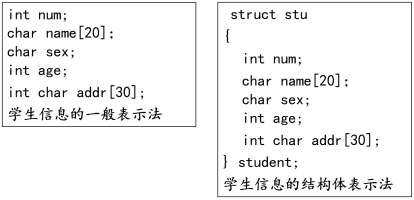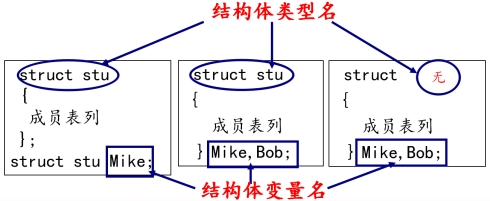C语言C语言结构体
苏丙榅1. 结构体的定义和使用
在前面的章节中学习了数组,它描述的是一组具有相同类型数据的有序集合,用于处理大量相同类型的数据运算。
有时我们需要将不同类型的数据组合成一个有机的整体,如:一个学生有学号/姓名/性别/年龄/地址等属性。显然单独定义以上变量比较繁琐,数据不便于管理。
C语言中给出了另一种构造数据类型——结构体。

1.1 定义和初始化
声明一个结构体类型的语法是:
1
2
3
4
5
6
| struct 结构体名
{
成员类型 成员名1;
成员类型 成员名2;
...
};
|
结构体类型是一种复合类型,说得更直白一些就是自定义类型,通过上面的语法将结构体类型定义出来之后,就可以基于这种类型定义变量了。
定义结构体变量的语法为:
在一个结构体变量内部有若干个成员,访问结构体成员的语法为:
其实,定义结构体变量有三种方式,如下图:
先声明结构体类型,再定义相应的变量
在声明类型的同时定义变量
直接定义结构体类型变量(无类型名)

结构体类型和结构体变量关系:
1
2
3
4
5
6
7
8
9
10
11
12
13
14
15
16
17
18
19
20
21
|
struct Student
{
char name[50];
int age;
};
struct Student s1 = { "tom", 18 };
struct Student2
{
char name[50];
int age;
}s2 = { "lily", 22 };
struct
{
char name[50];
int age;
}s3 = { "jack", 25 };
|
上面的示例代码中,基于三种方式定义了三个结构体变量s1、s2、s3,并通过{}对结构体变量中的各个成员依次进行了初始化。
1.2 成员访问
在一个结构体变量内部有若干个成员,访问结构体成员的语法为:
通过上面的方式我们就可以读出结构体变量中各个成员的值,或者给结构体变量的成员进行赋值操作。
1
2
3
4
5
6
7
8
9
10
11
12
13
14
15
16
17
18
19
20
21
22
23
24
| #include <stdio.h>
#include <string.h>
struct Student
{
char name[50];
int age;
};
int main()
{
struct Student s1;
strcpy(s1.name, "luffy");
s1.age = 18;
printf("s1.name = %s, s1.age = %d\n", s1.name, s1.age);
struct Student s2 = s1;
printf("s2.name = %s, s2.age = %d\n", s2.name, s2.age);
return 0;
}
|
相同类型的两个结构体变量,可以相互赋值,上面代码中把s1变量各个成员的值拷贝到了s2变量的各个成员对应的内存中。s1和s2只是成员变量的值一样而已,它们对应的是不同的两块内存。
1.3 嵌套使用
由于结构体是一种复合类型,有时候需要通过一个结构体来描述相对复杂的数据,此时可能就需要让多个结构体之间进行嵌套。
1
2
3
4
5
6
7
8
9
10
11
12
13
14
15
16
17
18
19
20
21
22
23
24
25
26
27
28
29
30
| #include <stdio.h>
#include <string.h>
struct Person
{
char name[20];
char sex;
};
struct Student
{
int id;
struct Person info;
};
int main()
{
struct Student s;
s.id = 1;
s.info.sex = 'W';
strcpy(s.info.name, "Lucy");
struct Student s1 = { 2, "Tom", 'M'};
printf("s.id = %d, s.info.name=%s, s.info.sex=%c\n",
s.id, s.info.name, s.info.sex);
printf("s1.id = %d, s1.info.name=%s, s1.info.sex=%c\n",
s1.id, s1.info.name, s1.info.sex);
return 0;
}
|
在上面的示例代码中,每个Student变量中都包含一个Person变量,二者之间是父子节点的关系。
2. 结构体数组和指针
2.1 结构体数组
如果想要记录某个学生的信息可以使用结构体,如果想要记录班级或者小组的学生信息就需要定义多个结构体变量,此时就可以使用数组。
下面的示例程序中使用结构体数组对小组中的学生成绩进行了统计:
1
2
3
4
5
6
7
8
9
10
11
12
13
14
15
16
17
18
19
20
21
22
23
24
25
26
27
28
29
30
31
32
33
34
35
36
37
38
39
40
41
42
|
struct Student
{
int num;
char name[20];
char sex;
float score;
};
int main()
{
struct Student stu[5] = {
{ 101, "Li ping", 'M', 45 },
{ 102, "Zhang ping", 'M', 62.5 },
{ 103, "He fang", 'W', 93 },
{ 104, "Cheng ling", 'W', 87 },
{ 105, "Wang ming", 'M', 58 }
};
int loser = 0;
float avg, total = 0;
for (int i = 0; i < 5; i++)
{
total += stu[i].score;
if (stu[i].score < 60)
{
loser += 1;
}
}
printf("total = %.2f\n", total);
avg = total / 5;
printf("average = %.2f, loser count = %d\n", avg, loser);
for (int i = 0; i < 5; i++)
{
printf(" name = %s, score = %.2f\n", stu[i].name, stu[i].score);
}
return 0;
}
|
结构体数组的使用方式和非结构体数组相同,都是通过[]对数组中的元素进行访问,只不过结构体数组元素更加复杂,还需要使用该元素再通过.的方式对结构体成员进行数据的读或写操作。
2.2 结构体指针
2.2.1 普通结构体指针
如果定义了一个结构体变量,我们可以再定义一个相同类型的指针,使用这个指针指向结构体变量的地址,示例代码如下:
1
2
3
4
5
6
7
8
9
10
11
12
13
14
15
16
17
18
19
| #include<stdio.h>
struct Student
{
char name[50];
int age;
};
int main()
{
struct Student s1 = { "lily", 18 };
struct Student* p = &s1;
printf("p->name = %s, p->age=%d\n", p->name, p->age);
printf("(*p).name = %s, (*p).age=%d\n", (*p).name, (*p).age);
return 0;
}
|
关于结构体内部成员的访问有两种情况:
- 基于结构体
变量进行访问,语法为:变量名.成员名
- 基于结构体
指针进行访问,语法为:指针名->成员名
如果对结构体指针通过*进行了解引用(比如代码中的 *p),那么它们的组合将不再是指针,在访问结构体成员的时候需要通过.进行操作(比如:(*p).name)
2.2.2 堆区结构体指针
如果在函数体内部定义结构体变量,那么该变量对应的内存位于栈区,如果在函数体外部定义结构体变量,那么该变量对应的内存位于全局数据区,除此之外我们还可以在函数体内部使用malloc动态申请一块堆区内存,并将这块内存的地址保存到一个指针变量中。
下面的示例代码给大家演示了如何给结构体动态申请一块堆内存:
1
2
3
4
5
6
7
8
9
10
11
12
13
14
15
16
17
18
19
20
21
22
23
24
25
26
27
| #include <stdio.h>
#include <string.h>
#include <stdlib.h>
struct Student
{
char name[50];
int age;
};
int main()
{
struct Student* p;
p = (struct Student*)malloc(sizeof(struct Student));
strcpy(p->name, "Monkey·D·Luffy");
p->age = 22;
printf("p->name = %s, p->age = %d\n", p->name, p->age);
printf("(*p).name = %s, (*p).age = %d\n", (*p).name, (*p).age);
free(p);
p = NULL;
return 0;
}
|
在C语言中,通过malloc/calloc/realloc函数动态申请的堆内存是不会自动释放的,在使用完毕之后需要手动进行释放,释放函数是free。
2.2.3 结构体嵌套指针
在定义结构体的时候,结构体成员可以是基础数据类型,可以是结构体类型,也可以是指针。如果是指针,它自身占4字节或者8字节的存储空间并且指针指向的位置是随机的,在使用的时候需要让它指向一个正确的、合法的地址。
下面是一段结构体嵌套指针的示例代码:
1
2
3
4
5
6
7
8
9
10
11
12
13
14
15
16
17
18
19
20
21
22
23
24
25
26
27
28
29
30
31
32
33
34
35
36
| #include <stdio.h>
#include <string.h>
#include <stdlib.h>
struct Student
{
char* name;
int age;
};
int main()
{
char* str = "Monkey·D·Luffy";
struct Student* p = (struct Student*)malloc(sizeof(struct Student));
p->name = (char*)malloc(strlen(str) + 1);
strcpy(p->name, "Monkey·D·Luffy");
p->age = 22;
printf("p->name = %s, p->age = %d\n", p->name, p->age);
printf("(*p).name = %s, (*p).age = %d\n", (*p).name, (*p).age);
if (p->name != NULL)
{
free(p->name);
p->name = NULL;
}
if (p != NULL)
{
free(p);
p = NULL;
}
return 0;
}
|
在上面的程序中,一共手动申请了两块堆内存:
结构体指针 p,通过malloc操作,该指针指向的内存大小为4+4=8字节
- age 整形变量,4字节
- name 整形指针,Win32平台4字节(Win64平台8字节),不能存储数据
结构体成员 p->name,如果想要通过指针来存储数据,那么指针必须要指向一块有效的存储空间,这块存储空间默认是没有的,所以需要再通过malloc分配出这块堆内存,并把得到的地址保存到p->name指针中。
所以在释放内存的时候,需要对这两个指针依次进行判断,然后再调用free函数,手动的将堆内存还给操作系统。
3. 结构体做函数参数
3.1 普通结构体变量
在定义函数的时候,可以将形参指定为结构体类型,示例代码如下:
1
2
3
4
5
6
7
8
9
10
11
12
13
14
15
16
17
18
19
20
21
22
23
24
25
26
| #include <stdio.h>
#include <string.h>
struct Student
{
char name[50];
int age;
};
void initStudent(struct Student tmp)
{
strcpy(tmp.name, "robin");
tmp.age = 35;
printf("tmp.name = %s, tmp.age = %d\n", tmp.name, tmp.age);
}
int main()
{
struct Student s = { "Luffy", 20 };
initStudent(s);
printf("s.name = %s, s.age = %d\n", s.name, s.age);
return 0;
}
|
程序输出的结果如下:
1
2
| tmp.name = robin, tmp.age = 35
s.name = Luffy, s.age = 20
|
上面程序中定义了一个函数initStudent(struct Student tmp),通过该函数来设置结构体变量中的初始值,但是通过输出的信息可以看出外部变量s中的值并没有被修改,原因是这样的:结构体变量的传递方式是值传递,值传递过程中会发生数据的拷贝,在 initStudent 函数内部修改是形参对应的内存中的值,对实参变量的内存数据没有任何影响,想要解决这个问题需要将参数修改为结构体指针类型。
3.2 结构体指针变量
修改一下上面的代码,将参数的类型由结构体类型替换为结构体指针类型:
1
2
3
4
5
6
7
8
9
10
11
12
13
14
15
16
17
18
19
20
21
22
23
24
25
26
27
| #include <stdio.h>
#include <string.h>
struct Student
{
char name[50];
int age;
};
void initStudent(struct Student* tmp)
{
strcpy(tmp->name, "robin");
tmp->age = 35;
printf("tmp.name = %s, tmp.age = %d\n", tmp->name, tmp->age);
}
int main()
{
struct Student s = { "Luffy", 20 };
printf("s.name = %s, s.age = %d\n", s.name, s.age);
initStudent(&s);
printf("s.name = %s, s.age = %d\n", s.name, s.age);
return 0;
}
|
程序输出的结果如下:
1
2
3
| s.name = Luffy, s.age = 20
tmp.name = robin, tmp.age = 35
s.name = robin, s.age = 35
|
可以看到,调用了initStudent函数之后,实参s中的数据确实被修改了,因为函数参数传递的是地址,在函数体内部形参指针指向的内存和实参变量对应的内存是同一块,通过这种方式就可以在函数体内部来修改函数体外部的变量数据了。
如果函数的形参是指针类型,我们还可以使用const关键字对其进行修饰,这样就可以限制使用者只能通过形参读内存数据,而不能修改内存数据。
1
2
3
4
5
6
7
8
9
10
11
12
13
14
15
16
17
18
19
20
21
22
23
24
|
struct Student
{
char name[50];
int age;
};
void func1(struct Student* const p)
{
p->age = 10;
p = NULL;
}
void func2(const struct Student* p)
{
p = NULL;
p->age = 10;
}
void func3(const struct Student* const p)
{
p = NULL;
p->age = 10;
}
|
在上面的示例代码中一共定义了三个函数,每个函数的参数类型都不同:
void func1(struct Student* const p)
- const 在 * 号右侧,修饰指针
- 指针指向的地址不可变,指向的地址中的值可变
void func2(const struct Student* p)
- const 在 * 号左侧,修饰指针指向的内存地址中的值
- 指针指向的地址可变,指向的地址中的值不可变
void func3(const struct Student* const p)
- const 在 * 号左右两侧,修饰指针和指针指向的内存地址中的值
- 指针指向的地址不可变,指向的地址中的值也不可变
3.3 结构体数组
除了使用结构体指针,结构体数组名也可以作为函数的形参,示例代码如下:
1
2
3
4
5
6
7
8
9
10
11
12
13
14
15
16
17
18
19
20
21
22
23
24
25
26
27
28
29
30
31
32
33
34
35
36
37
| #include <stdio.h>
#include <string.h>
struct Student
{
char name[50];
int age;
};
void initStudent(struct Student tmp[], int n)
{
int i = 0;
for (i = 0; i < n; i++)
{
sprintf(tmp->name, "name-%d", i);
tmp->age = 20 + i;
tmp++;
}
}
int main()
{
struct Student s[3] = { 0 };
int i = 0;
int size = sizeof(s) / sizeof(s[0]);
initStudent(s, size);
for (i = 0; i < size; i++)
{
printf("%s, %d\n", s[i].name, s[i].age);
}
return 0;
}
|
在上面的代码中将initStudent函数的形参指定为了结构体数组类型,其实它有两种书写形式:
void initStudent(struct Student tmp[], int n)
void initStudent(struct Student tmp[100], int n)
但是,不论将数组参数指定为何种形式,最终都将退化为指针,也就是这种形式:
1
| void initStudent(struct Student* tmp, int n);
|
因此,在函数体内部是不能通过sizeof运算符计算出指针指向的内存所占用的内存地址的大小的,如果需要在函数体内部使用这个值,则需要额外添加参数来进行数据的传递,这就是参数n的由来。

























